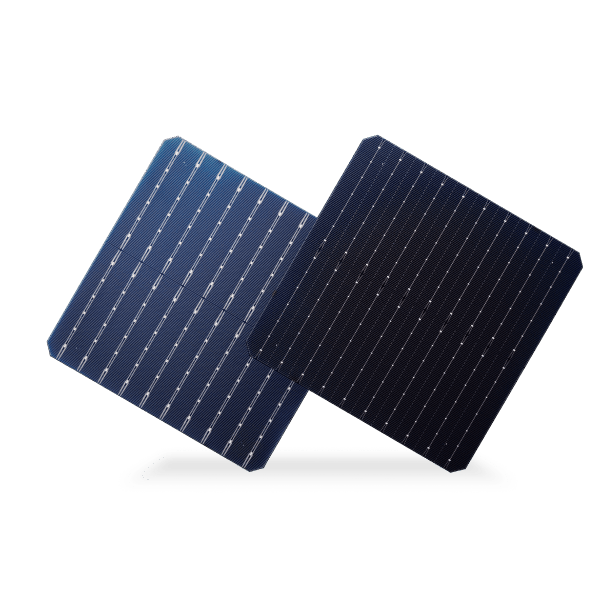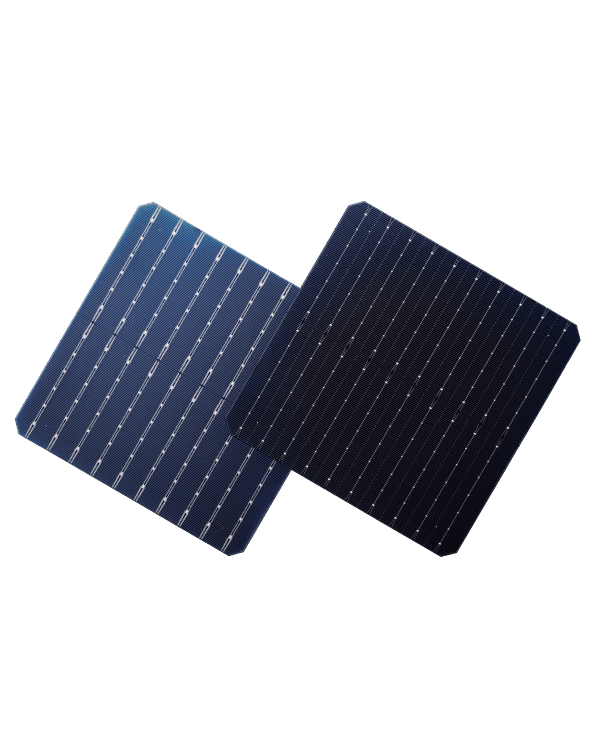Main Products
-
Dimension
182.2mm*182.2mm±0.5mm
-
Thickness
130±13μm 140±14μm 150±15μm
160um±16um 165±16.5um -
Front (-)
0.036±0.02mm bus bars(silver)
black anti-reflecting coating(silicon nitride) -
Back (+)
0.036±0.02mm bus bars(silver)
black anti-reflecting coating(silicon nitride)


Product Superiority
-
High Conversion Efficiency
The battery has high conversion efficiency, superior interface passivation and carrier transport capacity, and high UOC and FF.
-
Low Light Attenuation
The production line of process equipment has high compatibility and can be compatible with the high-temperature production line of PERC and N-PERT double-sided batteries.

-
High Compatibility
The light attenuation is low, and the boron content in phosphorus doped N-type crystalline silicon is extremely low, whic
-
Stack Technology Combination
The combination of N-type TOPCon batteries with SE, IBC, multiple main grids, and stacked technology significantly improves battery efficiency and module power.

-
High Conversion Efficiency
The battery has high conversion efficiency, superior interface passivation and carrier transport capacity, and high UOC and FF.
-
Low Light Attenuation
The production line of process equipment has high compatibility and can be compatible with the high-temperature production line of PERC and N-PERT double-sided batteries.
-
High Compatibility
The light attenuation is low, and the boron content in phosphorus doped N-type crystalline silicon is extremely low, whic
-
Stack Technology Combination
The combination of N-type TOPCon batteries with SE, IBC, multiple main grids, and stacked technology significantly improves battery efficiency and module power.
Electric Performance Parameters
| Eta(%) | Pmpp(W) | Umpp(V) | Impp(A) | Uoc(V) | Isc(A) | FF(%) |
|---|---|---|---|---|---|---|
| 26.20% | 8.66 | 0.642 | 13.5037 | 0.7369 | 13.6973 | 85.827 |
| 26.10% | 8.63 | 0.638 | 13.5326 | 0.7361 | 13.6634 | 85.849 |
| 26.00% | 8.60 | 0.640 | 13.4305 | 0.7358 | 13.6804 | 85.439 |
| 25.90% | 8.57 | 0.642 | 13.3427 | 0.73471 | 13.6157 | 85.632 |
| 25.80% | 8.53 | 0.638 | 13.3733 | 0.73198 | 13.6055 | 85.699 |
| 25.70% | 8.50 | 0.637 | 13.3516 | 0.73299 | 13.6402 | 85.033 |
| 25.60% | 8.47 | 0.633 | 13.3752 | 0.72943 | 13.6366 | 85.127 |
| 25.50% | 8.43 | 0.634 | 13.3105 | 0.72664 | 13.6184 | 85.234 |
| 25.40% | 8.40 | 0.630 | 13.343 | 0.73138 | 13.6099 | 84.406 |
| 25.30% | 8.37 | 0.631 | 13.2609 | 0.72774 | 13.6252 | 84.395 |
| 25.20% | 8.34 | 0.632 | 13.1982 | 0.72924 | 13.6144 | 83.959 |
| 25.10% | 8.30 | 0.629 | 13.1987 | 0.71831 | 13.6536 | 84.645 |
| 25.00% | 8.27 | 0.627 | 13.1874 | 0.72053 | 13.625 | 84.232 |
| 24.90% | 8.23 | 0.625 | 13.1743 | 0.71879 | 13.5897 | 84.288 |
| 24.80% | 8.20 | 0.623 | 13.1577 | 0.71818 | 13.6069 | 83.928 |
| 24.70% | 8.17 | 0.625 | 13.0761 | 0.71528 | 13.6047 | 83.941 |
Key Specifications
| Illumination intensity | 1000W/m² |
| Spectrum | AM1.5G |
| Test temperature | 25℃ |
| Current Temperature Coefficient | 0.048%/K |
| Voltage Temperature Coefficient | -0.30%/K |
| Power Temperature Coefficient | -0.38%/K |
Note: The above technical parameters are subject to technical changes and tests, and EliTe Solar. reserves the right of final interpretation.
FAQ
-
QWhat is the difference between solar panels and solar cells?A
Although solar cells and solar panels both sound similar, the working mechanism applied for each differs. A solar cell is made from such materials as monocrystalline silicon wafers designed to capture and convert solar energy into usable electrical power as efficiently as possible. As a solar cell company, we do the design, manufacturing, and distribution of photovoltaic cells, which is an essential product in the renewable energy industry.
Solar panels, referred to as photovoltaic modules, comprise a chain of interconnected solar cells that get electricity from the sun. Solar cells are the primary building blocks within a solar panel structure. They convert sunlight directly into electric power in a process known as the photovoltaic effect.
-
QHow are solar cells made?A
Solar cells are manufactured with quality in mind to give the best possible performance and service life. High-purity monocrystalline silicon ingots undergo several treatments to result in extremely thin wafers. These monocrystalline silicon wafers serve as the basis of solar cells. The wafers must be processed on their surfaces to create semiconductor junctions, allowing the cell to have photovoltaic capability. This involves "doping" of the silicon with other materials in order that one side of the resulting p-n junction is negative and the other side is positive. Metal contact coatings are deposited on the surfaces of the wafer to allow the flow of electricity. The cells, when finished, are then combined with its other components and encapsulated in order to protect them from the elements. At Elite Solar, strict quality control is observed at each step of the production to ensure the quality of the produced solar cells.
-
QWhat are Tier 1 solar modules?A
Tier 1 solar modules are distinguished by their manufacture from companies that are well-established, financially stable, and have demonstrated significant industry presence. These manufacturers have fully automated production plants and are often fully integrated, covering all aspects of the manufacturing process. Our Tier 1 PV modules, at Elite Solar, are from an innovative and advanced manufacturing process. The companies will be reviewed every quarter based on information added to BloombergNEF's database. Only project financings for over 5MW of capacity are relevant to tiering.
-
QCan these solar panels be ground-mounted?A
Yes, Elite Solar solar panels can be mounted on the ground. Ground-mounted solar panels are a popular option commercial property owner with large ground space, as this allows the best positioning and orientation toward the sun. Furthermore, Elite Solar ground-based solar panels offer a certified robust design against high wind and snow loads, hence guaranteeing longevity in harsh environments and the maintenance of high performance.
-
QWhat is the average lifespan of a solar module?A
Generally, solar modules are designed to have a long operational lifespan, typically lasting 25 to 30 years. However, many panels continue to function efficiently well beyond this timeframe with minimal degradation in performance. This is the reason solar modules' warranty through Elite Solar’s solar panels are extended up to 30 years; it mirrors our confidence in their longevity and performance. As a professional photovoltaic module manufacturer, we design our PV modules with technologies that minimize power degradation and resist environmental stressors, making them a reliable long-term investment in renewable energy.
Contact Us



